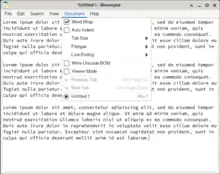Mousepad (software)
Mousepad is a graphical text editor written for Xfce, a Linux desktop environment.[7] The program has a small footprint, similar to Leafpad,[7] but has additional features such as plugins, search history and automatic reloading.[8] The name Mousepad is derived from the mouse in Xfce's logo.[9]
 | |
 | |
| Original author(s) | Erik Harrison, Benedikt Meurer, Tarot Osuji[1] |
|---|---|
| Developer(s) | Erik Harrison, Nick Schermer, Benedikt Meurer, Matthew Brush, Gaël Bonithon[1] |
| Initial release | April 17, 2006[2] |
| Stable release | 0.6.1[3]
/ May 13, 2023 |
| Repository | gitlab |
| Written in | GTK[3] |
| Operating system | Unix-like |
| Platform | x86 64, aarch64, ppc64, i686, ARMhf[4] |
| Included with | Xfce |
| Predecessor | Leafpad |
| Size | 436.2 kB[5] |
| Type | Text editor |
| License | GPL-2.0-or-later[6] |
| Website | docs |
Mousepad was originally written as a fork of an existing text editor, Leafpad,[10] to improve support for printing.[11][12] It was rewritten in December 2012 with version 0.3.0, which replaced the original code with a complete rewrite.[13]
Though written for Linux, Mousepad is has been ported to FreeBSD[14] and is also available for macOS via MacPorts,[15] and Microsoft Windows via Cygwin.[16] It is the default text editor for Linux distributions that use Xfce, such as Xubuntu.[17] Kali Linux uses Mousepad as its default text editor, but modifies the code to add a newline at the end of files so that they are POSIX-compliant and do not merge when printing multiple files back-to-back.[18]
Features
In addition to plugin support,[8] Mousepad has features including tabs,[19] copy and paste, Undo/Redo, drag and drop, keyboard shortcuts,[20] printing, UTF-8 support, line numbers, searching capabilities (with a replace option), font selection, word wrap, automatic and multi-line indent, and both auto character coding detection and manual codeset options.[21]
Dependencies
Compiling Mousepad requires gtksourceview4-4.8.3, which is a library for GTK+ text and visuals, and is used for installing themes.[22] DConf-0.40.0, a dconf package, and dbus-glib-0.112, a GLib tool to interface with D-Bus, are both optional dependencies, along with gspell, a spell-checker, and libxfce4ui, which may be used to display a widget in the XFCE desktop environment.[23][24]
References
- "Index of /src/apps/mousepad/0.2/". archive.xfce.org. Archived from the original on August 14, 2022. Retrieved August 22, 2022.
- "Mousepad". gitlab.xfce.org. 13 May 2023. Retrieved July 27, 2023.
- "0.5.10 – Packages – GNU Guix". guix.gnu.org. Archived from the original on January 11, 2023. Retrieved August 22, 2022.
- "Arch Linux – mousepad 0.5.10-1". ArchLinux.org. July 9, 2022. Archived from the original on September 3, 2022. Retrieved August 22, 2022.
- "COPYING". gitlab.xfce.org. 10 March 2022. Archived from the original on August 22, 2022. Retrieved August 22, 2022.
- Germain, Jack M. (August 22, 2012). "For Modest Mousepad, Simplicity Is Both Virtue and Vexation". Linux Insider. Archived from the original on August 22, 2022. Retrieved August 22, 2022.
- Nestor, Marius (May 2, 2022). "Roundup of Xfce's Apps Update for April 2022: New Releases of Mousepad, Xfce Terminal, and Thunar". Linux Today. Archived from the original on August 15, 2022. Retrieved August 22, 2022.
- Kowalewski, Hubert (2008-07-01). "Conceptual blending and sign formation". Public Journal of Semiotics. 2 (2): 30–51. doi:10.37693/pjos.2008.2.8826. ISSN 1918-9907. Archived from the original on 2022-08-23. Retrieved 2022-08-23.
- "Template file for 'mousepad'". GitHub. Archived from the original on August 14, 2022. Retrieved August 14, 2022.
Simple text editor for Xfce based on Leafpad
- Wallen, Jack (May 5, 2010). "Mousepad: A variation on the Leafpad theme". Ghacks. Archived from the original on August 24, 2022. Retrieved August 23, 2022.
- "Package: mousepad (0.5.10-1)". packages.debian.org. Debian. Archived from the original on December 29, 2013. Retrieved August 22, 2022.
- "mousepad/News". Xfce. Archived from the original on January 9, 2022. Retrieved August 14, 2022.
- "Port Details – mousepad Simple text editor for the Xfce Desktop". FreshPorts.org. July 20, 2022. Archived from the original on August 22, 2022. Retrieved August 22, 2022.
- "Install mousepad on macOS with MacPorts". MacPorts.org. Archived from the original on August 22, 2022. Retrieved August 22, 2022.
- "Cygwin Package Summary for mousepad". Cygwin.com. Archived from the original on August 23, 2022. Retrieved August 23, 2022.
- "Review – Xubuntu 19.10" (PDF). Full Circle Magazine. November 2019. p. 42. Archived (PDF) from the original on November 29, 2019. Retrieved September 26, 2022.
- "Kali Linux 2022.3". TechSpot. August 10, 2022. Archived from the original on September 25, 2022. Retrieved September 26, 2022.
- "Mousepad : A Simple And Useful Text Editor For Linux Mint". IHaveAPC.com. January 8, 2020. Archived from the original on June 26, 2022. Retrieved August 22, 2022.
- McManus, Sean; Cook, Mike (2021). Raspberry Pi For Dummies (4th ed.). Hoboken, NJ: Wiley. p. 71. ISBN 978-1119796824. OCLC 1250377754. Archived from the original on 2023-01-11. Retrieved 2022-08-23.
- "Simple text editor for Xfce desktop environment". RepoScope.com. Archived from the original on August 22, 2022. Retrieved August 22, 2022.
- King, Bertel (June 20, 2017). "Write or Code Faster in Your Linux Text Editor With Custom Themes". MakeUseOf. Archived from the original on August 23, 2022. Retrieved August 23, 2022.
- "mousepad". XFCE GitLab (Markdown). 11 March 2022. Archived from the original on 2022-12-06. Retrieved 2022-12-06.
- "Mousepad–0.5.10". LinuxFromScratch.org. Archived from the original on August 11, 2022. Retrieved August 22, 2022.